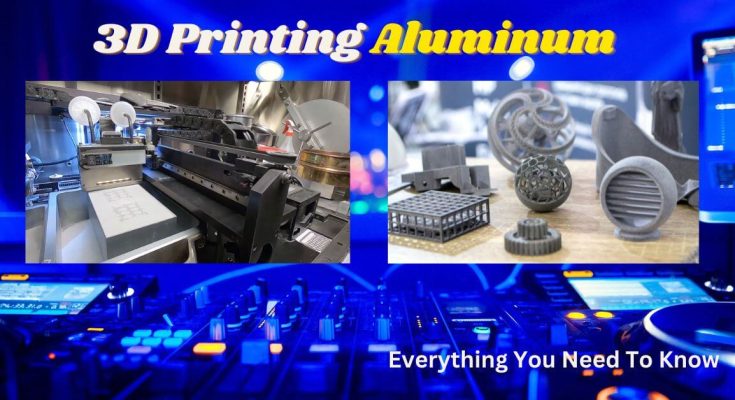1. Introduction To 3D Printing Aluminum
3D printing, also known as additive manufacturing, has revolutionized various industries by enabling the creation of complex and customized objects with unprecedented ease. While 3D printing was initially limited to plastic materials, advancements in technology have now made it possible to 3D print with metals, including aluminum. Aluminum, with its desirable properties such as lightweight, high strength, and excellent thermal conductivity, has gained significant attention in the 3D printing world.
The 3D printer utilizes metal powder, typically aluminum alloy, as the raw material. This metal powder is deposited layer by layer and selectively melted or sintered using various techniques to form the desired object. Let’s explore some of the key aspects of 3D printing aluminum.
1. Aluminum Alloy Selection: There are different aluminum alloys available for 3D printing, each with unique properties suited for specific applications. Common aluminum alloys used in 3D printing include AlSi10Mg, Al6061, and Al7075. These alloys offer a balance of strength, ductility, and heat resistance, making them suitable for various industries like aerospace, automotive, and manufacturing.
2. Powder Bed Fusion Techniques: The most common 3D printing technique for aluminum is powder bed fusion, specifically selective laser melting (SLM) or electron beam melting (EBM). In SLM, a high-powered laser selectively fuses the aluminum powder particles together, layer by layer, based on the digital design. EBM employs an electron beam to melt and fuse the powder. Both techniques ensure precise control over the melting and solidification process, resulting in high-quality printed parts.
3. Heat Management: Aluminum’s high thermal conductivity can pose challenges during the 3D printing process. Proper heat management is crucial to prevent distortion, warping, or cracking of the printed parts. Manufacturers employ techniques like preheating the build plate, optimizing laser power and scanning speed, and implementing controlled cooling strategies to ensure dimensional accuracy and reduce thermal stress.
4. Post-Processing and Finishing: Once the aluminum part is printed, it often requires post-processing to achieve the desired surface finish and mechanical properties. This can involve removing support structures, heat treatment processes like stress relieving or solution heat treatment, and CNC machining for precise dimensional control.
5. Applications of 3D Printed Aluminum: 3D printing aluminum opens up a wide range of possibilities. Its lightweight and high strength-to-weight ratio make it ideal for aerospace components, such as complex structural parts, brackets, and heat exchangers. In automotive industries, 3D printed aluminum finds applications in engine components, lightweight body parts, and customized prototypes. It is also utilized in the manufacturing sector for tooling, molds, and jigs.
2. The Process Of 3D Printing Aluminum
The process of 3D printing aluminum involves several steps. Here’s a general overview of the process:
1. Design: The first step is to create a digital 3D model of the desired object using computer-aided design (CAD) software. The design should consider factors like structural integrity, support requirements, and printing limitations specific to aluminum.
2. Slicing: The 3D model is then sliced into thin cross-sectional layers using slicing software. Each layer acts for a physical layer that is printed.
3. Preparing the printer: The 3D printer needs to be prepared for printing aluminum. This includes ensuring the printer’s build plate is clean and properly leveled. Additionally, the print chamber may need to be heated to maintain a controlled temperature during the printing process.
4. Material preparation: Aluminum powder or filament is typically used as the raw material for 3D printing aluminum. The powder can be spread in thin layers or the filament can be fed into the printer, depending on the specific printing technology being used.
5. Printing: The 3D printer deposits the aluminum material layer by layer according to the sliced model. Various 3D printing technologies can be used for aluminum, including selective laser melting (SLM) and direct metal laser sintering (DMLS). These processes use a high-powered laser to selectively melt or sinter the aluminum powder or filament, fusing it together to form each layer.
6. Support structures: If the design requires it, support structures may be printed alongside the object to provide stability during the printing process. These supports are typically made of a different material that is easier to remove once printing is complete.
7. Post-processing: Once the printing is finished, the object is removed from the build plate. The printed part may undergo post-processing steps, such as heat treatment or stress relieving, to enhance its mechanical properties and reduce residual stresses. Support structures, if present, are removed, and any necessary surface finishing processes, such as machining or polishing, may be performed.
It’s important to note that specific details and techniques can vary depending on the type of 3D printing technology used and the equipment being utilized. Additionally, working with aluminum in 3D printing can require specialized equipment and expertise due to its unique properties and challenges.
3. The Benefits Of 3D Printing Aluminum
There are several benefits associated with 3D printing aluminum. Let us present some attractive benefits here:
1. Lightweight and High Strength: Aluminum is a lightweight metal known for its excellent strength-to-weight ratio. 3D printing allows for the creation of complex structures and intricate geometries, enabling designers to optimize the part’s weight while maintaining its strength. This makes it particularly useful in industries such as aerospace and automotive, where lightweight components are essential for fuel efficiency and performance.
2. Design Freedom: 3D printing enables the production of complex designs that are difficult or impossible to manufacture using traditional methods. This includes intricate internal structures, lattices, and organic shapes. With aluminum 3D printing, designers have the freedom to create customized parts with unique geometries, enhancing functionality and performance.
3. Cost-Effective: While the initial setup costs of 3D printing can be high, it can offer significant cost advantages in certain scenarios. Traditional manufacturing methods often require the production of molds, tooling, and fixtures, which can be expensive and time-consuming. With 3D printing, these costs can be reduced or eliminated, especially for low-volume production runs or prototyping.
4. Faster Time to Market: 3D printing aluminum can accelerate the product development process by reducing the time required to produce prototypes and functional parts. The ability to quickly iterate designs and test them allows for faster iteration cycles, leading to shorter development times. This speed advantage can give businesses a competitive edge in bringing new products to market.
5. Material Efficiency: Additive manufacturing with aluminum can minimize material waste compared to subtractive manufacturing methods. Traditional manufacturing processes often involve cutting away excess material, resulting in significant waste. 3D printing, on the other hand, adds material layer by layer only where it is needed, optimizing material usage and reducing waste.
6. Enhanced Part Performance: Aluminum 3D printing allows for the production of parts with improved performance characteristics. For example, lattice structures can be integrated into designs to enhance stiffness, reduce weight, or facilitate heat transfer. Additionally, complex internal cooling channels can be incorporated into parts for improved thermal management, making it particularly beneficial for applications such as heat exchangers and electronics cooling.
7. Customization and Personalization: 3D printing allows to produce highly customized and personalized products in minutes. With aluminum 3D printing, it becomes possible to create bespoke components tailored to specific requirements, whether it’s in the medical field, consumer products, or industrial applications. This customization capability opens up new possibilities for product differentiation and customer satisfaction.
Overall, 3D printing aluminum offers numerous benefits, including lightweight and strong structures, design freedom, cost-effectiveness, faster time to market, material efficiency, enhanced part performance, and customization. As technology continues to advance, it is expected to find even broader applications across various industries.
4. Applications And Industries Using 3D Printed Aluminum
3D printing technology has revolutionized various industries by enabling the production of complex and customized parts. Aluminum, being a lightweight and durable material, is widely used in many applications. When it comes to 3D printing, aluminum finds its applications in several industries. Here are some examples:
1. Aerospace: The aerospace industry extensively uses 3D printed aluminum parts due to their high strength-to-weight ratio. Components such as engine parts, brackets, air ducts, and structural elements can be manufactured using aluminum 3D printing, reducing weight and improving fuel efficiency.
2. Automotive: In the automotive sector, 3D printed aluminum is employed to create lightweight and high-performance parts. This includes components like engine blocks, heat exchangers, suspension parts, and customized parts for concept cars or high-performance vehicles.
3. Defense: Defense organizations utilize 3D printed aluminum for various applications, including military equipment, aerospace systems, weapon components, and vehicle parts. The ability to produce complex geometries and lightweight structures makes aluminum 3D printing highly beneficial in this industry.
4. Medical: The medical field benefits from 3D printed aluminum components for prosthetics, orthopedic implants, surgical instruments, and customized medical devices. Aluminum’s biocompatibility, strength, and lightness make it suitable for many medical applications.
5. Industrial Manufacturing: 3D printed aluminum is used in industrial settings for the production of jigs, fixtures, tooling, and prototypes. These parts can be manufactured quickly and cost-effectively, enabling efficient manufacturing processes.
6. Electronics: Aluminum 3D printing is applied in the electronics industry to create heat sinks, enclosures, brackets, and connectors. The thermal conductivity and lightweight nature of aluminum make it ideal for managing heat dissipation in electronic devices.
7. Architecture and Construction: 3D printed aluminum is utilized in architectural projects and construction applications for creating intricate facades, structural elements, and building components. Aluminum’s durability, design flexibility, and corrosion resistance are advantageous in these applications.
8. Energy: Aluminum 3D printing finds its application in the energy sector for creating components such as heat exchangers, turbines, solar panels, and wind turbine parts. These parts can be tailored to specific energy generation requirements, optimizing performance and efficiency.
These are just a few examples of how 3D printed aluminum is being used in various industries. As technology advances, the range of applications and industries utilizing aluminum 3D printing is expected to grow even further.
5. Challenges Of 3D Printing Aluminum
When it comes to 3D printing with aluminum, there are several challenges that need to be addressed. While aluminum is a widely used material in various industries, its characteristics make it more complex to work with in the context of additive manufacturing. Here are some of the main challenges associated with 3D printing aluminum:
1. High melting point: Aluminum has a relatively high melting point compared to other commonly used 3D printing materials such as plastics. The melting point of aluminum is around 660 degrees Celsius (1220 degrees Fahrenheit). This high temperature requirement poses challenges for the equipment and technology used in the 3D printing process.
2. Thermal conductivity: Aluminum has excellent thermal conductivity, which means it dissipates heat quickly. During the 3D printing process, maintaining the appropriate temperature gradient across the printed part can be challenging. If the cooling rate is not controlled properly, it can result in thermal stresses and distortion in the printed object.
3. Oxidation: Aluminum readily reacts with oxygen in the air to form an oxide layer on its surface. This oxide layer can hinder proper bonding between layers during the 3D printing process. Special precautions must be taken to prevent or minimize oxidation, such as the use of inert gas environments or protective coatings.
4. Warping and cracking: Aluminum has a relatively high coefficient of thermal expansion, meaning it expands and contracts more than other materials when subjected to temperature changes. This can lead to warping and cracking issues during the 3D printing process, especially when dealing with large and complex geometries. Adequate support structures and optimized printing parameters are required to minimize these issues.
5. Printability and process optimization: Achieving optimal printability and process parameters for aluminum 3D printing can be a complex task. The selection of appropriate powder particle size, layer thickness, laser power, scanning speed, and other process parameters significantly affect the quality and mechanical properties of the printed parts. Iterative experimentation and process optimization are often necessary to achieve the desired results.
6. Cost: Aluminum is generally more expensive compared to common 3D printing materials like plastics. The cost of aluminum powders and specialized equipment for aluminum 3D printing can be a limiting factor for some applications.
Despite these challenges, advancements in technology and materials are continuously addressing these issues and expanding the possibilities of 3D printing with aluminum. With ongoing research and development, it is expected that these challenges will be mitigated, enabling wider adoption of aluminum in additive manufacturing processes.
6. Choosing The Right 3D Printer For Aluminum
When it comes to choosing a 3D printer for aluminum, there are a few factors to consider. Aluminum is a challenging material to 3D print due to its high melting point and thermal conductivity. However, there are specific types of 3D printers designed to handle aluminum printing. Here are some key considerations:
1. Selective Laser Melting (SLM) or Electron Beam Melting (EBM): These are the primary technologies used for aluminum 3D printing. SLM uses a high-powered laser to selectively melt aluminum powder, while EBM utilizes an electron beam. Both methods offer high precision and strength, but SLM is more commonly used for aluminum.
2. Build Volume and Bed Size: Determine the size of the objects you plan to print. Consider the maximum build volume and bed size of the 3D printer to ensure it can accommodate your desired aluminum prints.
3. Material Compatibility: Check if the 3D printer supports aluminum printing. Some machines are designed specifically for aluminum, while others may require additional modifications or upgrades to handle aluminum materials effectively.
4. Temperature Control: Aluminum requires a high melting temperature, so it’s crucial to choose a printer with excellent temperature control. Look for printers that can achieve and maintain the necessary temperatures for aluminum printing.
5. Support Structures and Powder Handling: Aluminum 3D printing often requires the use of support structures. Consider the printer’s capability to generate support structures and its ease of removal. Additionally, ensure the printer has proper powder handling systems for safety and efficiency.
6. Precision and Surface Finish: Evaluate the printer’s precision and the quality of the surface finish it can achieve with aluminum prints. Look for printers with high-resolution capabilities and smooth surface finishes for intricate designs.
7. Cost: Determine your budget for the 3D printer. Keep in mind that printers designed for aluminum printing are often more expensive due to their specialized features and capabilities.
8. User-Friendliness and Support: Consider the user-friendliness of the printer, including the availability of user guides, software compatibility, and technical support from the manufacturer or community.
It’s essential to research and compare different 3D printers dedicated to aluminum printing to find the one that meets your specific requirements. Consult with manufacturers, read user reviews, and consider seeking expert advice to make an informed decision.
7. Best Practices For Successful 3D Printing with Aluminum
Sure! Here are some best practices for successful 3D printing with aluminum:
1. Select the right printing method: There are different printing methods available for aluminum, such as Direct Metal Laser Sintering (DMLS) and Binder Jetting. Understand the advantages and limitations of each method to choose the one that suits your requirements.
2. Design considerations: Aluminum has unique properties that need to be considered during the design phase. Ensure proper wall thickness, avoid overhanging features, incorporate support structures if needed, and consider the shrinkage that occurs during the cooling process.
3. Material selection: Choose the appropriate aluminum alloy for your application. Different alloys have varying mechanical properties, such as strength, hardness, and corrosion resistance. Consult material data sheets or seek expert advice to select the right alloy for your specific needs.
4. Preparing the build plate: Proper surface preparation is crucial for adhesion and minimizing warping. Ensure the build plate is clean, free from debris, and adequately preheated to the recommended temperature for your specific aluminum powder or filament.
5. Printing environment: Maintain a controlled printing environment to prevent contamination and ensure consistent results. Avoid excessive drafts, temperature fluctuations, and exposure to moisture. Consider using an enclosed printer or installing a controlled environment chamber.
6. Support structures: Aluminum prints often require support structures to ensure successful printing and prevent deformation. Optimize support structures to minimize post-processing and reduce material waste.
7. Cooling and post-processing: Allow sufficient cooling time before removing the printed part from the build plate. Aluminum has a high thermal conductivity, so it’s important to prevent thermal stress during cooling. After printing, remove support structures carefully and perform any necessary post-processing steps, such as heat treatment, machining, or surface finishing.
8. Quality control: Implement quality control measures to ensure the dimensional accuracy and mechanical properties of the printed parts. Perform regular calibration of the printer, monitor critical parameters such as temperature and print speed, and conduct tests to verify the integrity of the printed parts.
9. Learn from experience: 3D printing with aluminum can be a learning process. Keep records of successful prints and failures, analyze the results, and adjust your parameters and techniques accordingly. Over time, you’ll gain valuable experience and optimize your printing process.
10. Seek expert advice: If you’re new to 3D printing with aluminum or facing challenges, don’t hesitate to seek advice from experts or consult online communities dedicated to additive manufacturing. They can provide guidance, troubleshooting tips, and insights based on their experiences.
Remember that these best practices provide general guidelines, and it’s essential to consider the specific requirements of your project and consult the documentation provided by your printer and material manufacturers for detailed instructions.
8. Tips For Successful 3D Printing In Aluminum
Here are some tips for successful 3D printing in aluminum:
1. Choose the right 3D printer: Aluminum 3D printing typically requires more advanced and specialized equipment compared to printing with other materials. Look for a 3D printer that is specifically designed for printing with metal, preferably one that uses a direct metal laser sintering (DMLS) or selective laser melting (SLM) process.
2. Understand the design limitations: Aluminum 3D printing has certain design limitations that you should be aware of. For example, overhanging features, unsupported structures, and large flat surfaces can lead to warping or distortion. It’s important to design your parts with these limitations in mind to ensure successful printing.
3. Optimize support structures: Since aluminum has a high melting point, it requires support structures during the printing process to prevent sagging or collapsing. These support structures are usually made of the same material as the part but are later removed. Optimize the placement and density of support structures to minimize post-processing efforts and achieve better surface finishes.
4. Control the printing environment: Aluminum is sensitive to temperature changes, so it’s important to control the printing environment. Ensure that the printer is located in a stable environment with controlled temperature and humidity levels to prevent issues like thermal distortion or inconsistent part quality.
5. Use suitable aluminum alloys: There are various aluminum alloys available for 3D printing, each with its own properties and characteristics. Select the alloy that best suits your application requirements in terms of strength, corrosion resistance, thermal conductivity, etc. Consult with material suppliers or experts to choose the right alloy for your specific application.
6. Post-processing considerations: Aluminum 3D printed parts often require post-processing to achieve the desired surface finish and dimensional accuracy. This may involve processes like machining, sanding, polishing, or heat treatment. Plan for these post-processing steps in your workflow and allocate time and resources accordingly.
7. Understand safety precautions: Working with aluminum powder and 3D printing equipment can pose safety risks. Make sure to follow all safety guidelines provided by the equipment manufacturer and use appropriate personal protective equipment (PPE) when handling aluminum powder or operating the printer.
8. Iterative improvement: Like any new manufacturing process, 3D printing in aluminum may require some trial and error to achieve optimal results. Learn from each print, iterate on your designs, and refine your process to continually improve the quality and efficiency of your aluminum 3D prints.
Remember that 3D printing with aluminum can be complicated and may require specialized knowledge and equipment. It’s always a good idea to consult with experts or experienced users in the field to gain additional insights and guidance specific to your application.
9. Conclusion: The Future Of 3D Printing Aluminum
The future of 3D printing aluminum holds great promise and potential. Over the past decade, advancements in 3D printing technology have revolutionized various industries, and aluminum is no exception. As research and development continue to progress, we can expect significant advancements and widespread adoption of aluminum 3D printing in the coming years.
One of the key advantages of 3D printing aluminum is its ability to produce complex geometries that would be difficult or impossible to achieve through traditional manufacturing methods. This opens up new design possibilities and allows for the creation of lightweight yet strong components. Aluminum’s favorable properties, such as high strength-to-weight ratio, corrosion resistance, and excellent thermal conductivity, make it an ideal material for a wide range of applications.
In terms of materials, there have been notable developments in aluminum alloy powders specifically formulated for 3D printing. These powders exhibit improved flowability, particle size distribution, and sphericity, enabling better print quality and mechanical properties in the final products. Researchers are also working on enhancing the post-processing techniques to further optimize the properties of printed aluminum parts, such as heat treatment and surface finishing.
Another area of advancement is the scalability and efficiency of aluminum 3D printing processes. Industrial-scale printers capable of producing larger and more complex parts are being developed, which will facilitate the adoption of aluminum 3D printing in various industries, including aerospace, automotive, and consumer goods. Additionally, improvements in printing speed and material utilization are being pursued to increase productivity and reduce costs.
Furthermore, advancements in machine learning and simulation techniques are expected to enhance the design and optimization of aluminum 3D printed components. This includes optimizing the internal structures and lattice patterns to maximize strength-to-weight ratios, improving thermal management, and reducing material waste. Such advancements will contribute to the overall efficiency and performance of aluminum 3D printed parts.
However, challenges still exist that need to be addressed for the widespread adoption of aluminum 3D printing. These include the cost of equipment, materials, and post-processing, as well as the need for standardization and certification processes. Additionally, further research is needed to fully understand the mechanical behavior and long-term reliability of aluminum 3D printed parts, especially in demanding applications.
In conclusion, in the world of hard competition and creativity, the future of 3D printing aluminum is much promising. With ongoing advancements in technology, materials, scalability, and optimization techniques, we can expect to see aluminum 3D printing playing a significant role in various industries. As the challenges are overcome and the technology matures, it has the potential to revolutionize manufacturing, enabling the production of highly customized, lightweight, and durable aluminum components with unprecedented design freedom.




